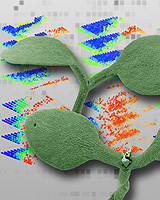Stem-Cell Control in Plants: The Crucial Gene
18 May 2010

To assure reproduction, plants have to carefully balance the number of their stem cells. Using a biological reference organism, Arabidopsis thaliana, scientists from Heidelberg, Tübingen and Santa Fe (Argentina) have completed a detailed study of the most important gene involved in this process. The team headed by Prof. Dr. Jan Lohmann (Heidelberg University) has uncovered how this “master regulator” functions and how the other molecular agents are influenced by it. The results, published today in Developmental Cell, also reveal surprising parallels with stem-cell control in animals.
The studies focussed on a regulatory gene called “Wuschel”. Its crucial importance for stem-cell control was already discovered 14 years ago. “Wuschel is the central switch by which plants regulate the number of their stem cells,” says Prof. Lohmann, head of the Department of Stem Cell Biology at Heidelberg University. The biologists have now identified almost 700 genes whose activity depends on Wuschel, about 130 of which are apparently under its direct control. As a transcription factor, Wuschel binds to regulatory parts of the DNA that can switch the gene on or off. These genes are mostly responsible for the metabolism of the plant, its development and hormone signalling.
To this extent, these findings square with classical observations about plant stem-cell control. “We knew that in addition to genetic factors, growth hormones like auxin and cytokinin participate in regulating the number of stem cells,” says Prof. Lohmann. But the recent experiments, conducted in the framework of Heidelberg University’s Cluster of Excellence “Cellular Networks”, have also yielded a number of new insights. They reveal that Wuschel not only influences the activity of cytokinin – as was already known – but also that of the second major hormonal agent, auxin. Accordingly, one of the crucial tasks of the Wuschel gene is to maintain the sensitive balance between these two hormones in the tip of the shoot.
The findings produced by the Heidelberg biologists assign a clearly defined role to the Wuschel gene. In the growth zones of the plant, it locally modulates the effect of freely circulating hormones in such a way that stem cells can thrive. “Mechanisms like these allow one and the same hormone to produce different effects in different tissues,” says Lohmann. The detailed analysis also demonstrated that Wuschel functions similarly to transcription factors involved in the creation and renewal of animal stem cells. To some extent, the control gene binds to identical DNA motifs. “The mechanisms of stem-cell control in plants and animals are more similar than we thought,” Prof. Lohmann concludes.
Note for news desks
Digital photo material is available from the Press Office.
Original publication
W. Busch, A. Miotk, F.D. Ariel, Z. Zhao, J. Forner, G. Daum, T. Suzaki, C. Schuster, S.J. Schultheiss, A. Leibfried, S. Haubeiß, N. Ha, R.L. Chan, and J.U. Lohmann: Transcriptional Control of a Plant Stem Cell Niche, Developmental Cell 18, 849-861, May 18, 2010, doi:10.1016/j.devcel.2010.03.012
Contact
Prof. Dr. Jan Lohmann
Institute of Zoology
phone: +49 6221 546269
jlohmann@meristemania.org
Communications and Marketing
Press Office, phone: +49 6221 542311
presse@rektorat.uni-heidelberg.de

